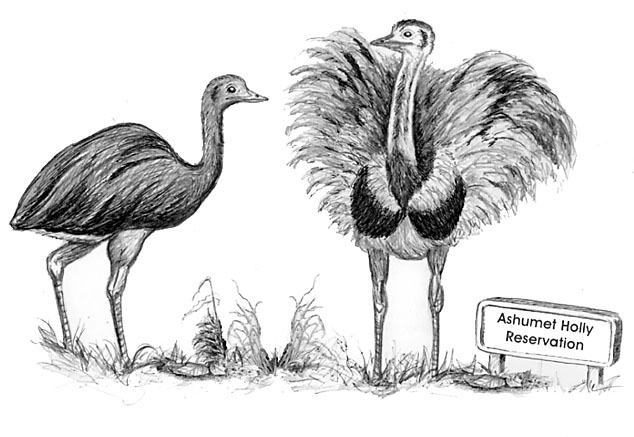
Dear Bird Folks,
I was reading on a birding blog that some guy from Pittsburgh is traveling to the Cape to see birds called “rheas.” First of all, I didn’t know what a rhea was until I looked it up. Second, what are flightless South American birds doing on Cape Cod and where can I see them?
– Edward, Wilmington, DE
You’re not alone, Ed,
When I received your note, I snickered a bit. Why would someone (you) be reading a birding blog and not know about rheas? When I mentioned your rhea note to my staff, I thought they would laugh too, but I was met by a wall of blank faces. So I apologize for snickering at you, Ed. It turns out you are smarter than the people I work with. Want a job?
For the sake of my staff and anyone else who doesn’t know about rheas, I’ll give a quick background. Rheas are flightless South American birds that stand five feet high and weigh up to sixty-five pounds. They are about half the size of their African cousin, the Ostrich, and a little smaller than the Australian Emu. And, in case you are wondering, rhea is pronounced “ree-ah.” People from eastern Massachusetts, who have accents like mine, need to be careful not to put an extra “r” at the end. The bird is not a “rear.”
Rheas live in a diversity of open habitats throughout the southeastern part of South America. They can be found roaming on the famous pampas or in the high plains of the Andes. They are omnivorous, eating plants, insects, lizards and slow moving gauchos. The rhea’s ability to eat anything, plus its adaptation to cold weather, is the major reason why it has flourished on a restricted area of Cape Cod.
How did they get here? Back in 1956 there was a major outbreak of ticks on the Massachusetts Military Reservation on the Upper Cape. Training on the 21,000-acre reservation was nearly halted because the soldiers were at risk of contracting tick-borne illnesses. They didn’t want to spray because of health concerns to the military personnel. (They didn’t care about groundwater back then.) So they decided to try a plan proposed by the staff entomologist, Lt. A. Kidder. The lieutenant had seen rheas in action while on a training exercise in Argentina. Rheas spend their entire day looking for food, with one of their favorite menu items being yummy ticks. The birds have excellent vision, allowing them to spot the tiniest ticks and pluck them off vegetation like they were grapes. Amazingly, the military’s plan actually worked. The introduced rheas chowed the ticks and cleared the way for the soldiers.
Well, that was forty years ago and the birds are still on the reservation and thriving. They are totally wild birds and require nothing from humans. They breed every spring and the new birds replace the old birds that are taken by coyotes. The reason why few of us have ever seen these Cape Cod rheas is because they can’t fly. The huge reservation is totally fenced in. Most people didn’t even know they were there until 1998, when a few birds found a break in the fence and went AWOL. Now every spring, for the past nine years, a flock of rheas slips through the fence to a “lek” they have established on the adjacent property, Mass. Audubon’s Ashumet Holly Reservation. For those who don’t know, a lek is an area that the male birds use to strut their stuff in front of the females.
It is quite a sight watching the massive males perform their elaborate mating dance. They prance about and kick dirt sometimes fifteen feet in the air. During this display, the birds can be quite aggressive. Spectators are required to carry, of all things, yo-yos. That’s right, yo-yos. It seems the birds have an innate fear of yo-yos because to them it’s a “bola.” Bolas are those weighted ropes that gauchos once used to hunt the rheas. One spin of a yo-yo and the birds back right off. Also, you may want take along a pair of table spoons. On some nights the birds stay back and don’t come into view. If that happens slap the spoons on your knee like a jug band performer does. The clacking spoons sound like bills snapping and the contentious birds pop out looking to defend their lek.
You should definitely put this amazing display of nature on your schedule, Ed. Cape Cod is the only place north of the equator where you can see these huge birds. And the best part is you don’t even have to walk far. You can see it all from the Sanctuary’s parking lot. Like clockwork, the birds arrive each spring at this lek, located at the Ashumet Holly Reservation, in E. Falmouth. It always happens just before sunset on the day of the spring’s first full moon. You should get there early because each year more and more people arrive to watch the show. Just in case you want to make it, this year’s show is expected to be this Sunday, April, 1st. That’s right, April, 1st. Have fun and don’t forget your yo-yo.